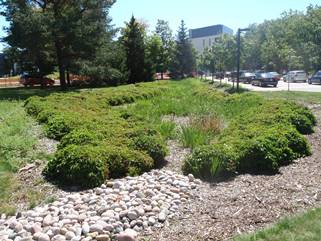Bioretention and Rain Gardens
 Bioretention is a stormwater infiltration practice that treats runoff from paved areas by using the natural properties of soil and vegetation to remove contaminants. Other names commonly used for these types of practices includes rain gardens, bioswales, dry swales, stormwater planters and biofilters. The practice has the potential to provide a significant improvement in contaminant removal over other stormwater infiltration practices due to the added treatment benefits of microbial activity and plant uptake. By infiltrating and evapotranspiring runoff volumes, bioretention systems also help to reduce pollutant loads to watercourses and recharge groundwater.
Bioretention is a stormwater infiltration practice that treats runoff from paved areas by using the natural properties of soil and vegetation to remove contaminants. Other names commonly used for these types of practices includes rain gardens, bioswales, dry swales, stormwater planters and biofilters. The practice has the potential to provide a significant improvement in contaminant removal over other stormwater infiltration practices due to the added treatment benefits of microbial activity and plant uptake. By infiltrating and evapotranspiring runoff volumes, bioretention systems also help to reduce pollutant loads to watercourses and recharge groundwater.
A variety of design variations of bioretention are possible. Most are designed as swales or islands and are constructed adjacent to roads, parking lots or other paved areas. Runoff from these impervious surfaces are directed into the bioretention area, where it ponds and slowly infiltrates. Flows from large rainfall events, bypass the bio-retention area and are conveyed directly to the sewer system.
While the specific components of a bioretention area may vary slightly, they generally consist of an organic mulch top layer with vegetation and filter media below. A gravel under-drain below the soil is provided in some applications. The soil underneath the mulch in bioretention areas consists predominantly of sand with smaller amounts of silt, clay and organic material, which helps increase infiltration rates and filter contaminants from surface runoff. The plants and mulch layer also help to improve infiltration and pollutant removal. The area is normally planted with native species which are tolerant to elevated contaminant levels and fluctuations in soil moisture.
Some bioretention systems do not allow for infiltration of stormwater into native soils below, and instead are designed with an impermeable liner at the bottom of the system, where flows are conveyed to the storm sewer system or receiving waters after they have infiltrated through the media. In this type of system, peak flows are attenuated and volumes are reduced due to evapotranspiration, but the system does not allow for groundwater recharge.
